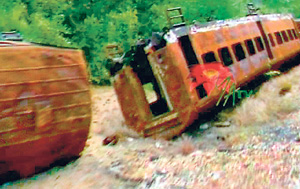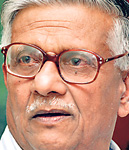The stentorian but monotonous voice still rings in memory……..the down-train from KKS bound for Colombo Fort will arrive on Platform 1 in a few minutes. It will stop at……
Vivid are the memories of scrambling into the compartments at Anuradhapura; people sprawled full-length across the seats fast asleep; tapping them awake to get some room to sit; and burly, bleary-eyed men sullenly and reluctantly stretching up off the seats.
By the time the “fast express” Yal Devi thunders into Polgahawela, the busy railway junction, leaving behind the harsh and stark beauty of the dry zone dotted with its lotus-studded tanks and unfolding vast vistas of coconut country, new friendships have been forged, with thosai, vadai and spicy sambal from ever silver tiffin-carriers being exchanged with seeni-sambol sandwiches and steaming cups of tea from flasks.
A care-free childhood in the sixties when train travel was the “in-thing” and trips not only south from Anuradhapura to Colombo but also north to Jaffna and Kankesanthurai (KKS in railway jargon) were commonplace.
It was the “northern line” with the Yal Devi or Princess of Jaffna ruling the tracks that formed the main artery joining north to south, bringing with it integration, exchange and friendship.
But no more -- for as the conflict tore apart this nation since the eighties and turned brother against brother, so did it destroy this friendship track and halted the majestic Yal Devi in its tracks beyond Vavuniya.
However, there is hope for the younger generation. Over two decades later, plans are underway to re-establish this vital link and breathe fresh vigour to this legendary princess, as peace looms large on the horizon. (See box)
Help rebuild this Friendship Track |
Under the Uthuru-Mithuru Project estimated to cost over Rs. 2 billion the Yal Devi track will be re-laid, the railway bridges rehabilitated or rebuilt, the stations reconstructed and a new signalling and communication system installed, says the ministry spokesperson.
Currently trains are operated up to Vavuniya.
Under the ambitious plans drawn up, townships are to be developed along the northern railway, while Vavuniya is to be made an economic and logistics centre, Paranthan an industrial centre with Jaffna taking pride of place as a metro urban centre.
 |
| The day Yal Devi was stopped in its track. Picture courtesy Transport Ministry/YA TV |
Please give generously to this project, appeals the spokesperson, explaining that public contributions could be in cash or kind.
“The public can make a monetary contribution or collectively undertake construction work on any of the sub-components of the project,” the spokesperson says citing the example of the people of Hambantota who have undertaken to construct the Jaffna railway station and the people of Matara the Kilinochchi station. |
In an attempt to recreate the early days of the railway, The Sunday Times goes down the tracks of time to 1910, when Henry W. Cave says in his book, ‘The Ceylon Government Railway’, “Her (Ceylon) railway now affords an easy and even luxurious means for reaching the most attractive parts of the country”, adding that “the NORTHERN LINE, one of the sections of the railway most recently completed, extends from its junction with the main line at Polgahawela (451/2 miles from Colombo) to Kankesanturai in the extreme north of the island, its distance from Polgahawela being 211 ¼ miles”.
The northern line branching off from the main line from Colombo at Polgahawela, had wound its way through Potuhera, Kurunegala, Wellawa, Ganewatte, Maho, Ambanpola, Galgamuwa, Talawa, Anuradhapura, Madawachchi, Vavuniya, Mankulam, Paranthan, Elephant Pass (halting place only), Pallai, Kodikamam, Chavakachcheri, Navatkuli, Jaffna, Chunakam and finally to KKS
The Northern Line rendered easily accessible the interesting peninsula of Jaffna, until quite recently so isolated from the capital that communication was only by sea or a most uncomfortable three to four days’ journey by cart road, according to Cave.
That easy accessibility and two-way interaction between Jaffna and the south were the very things that the Liberation Tigers of Tamil Eelam destroyed along with the camaraderie and oneness created by the northern line.
It was on March 25, 1986 that the Yal Devi was blasted between Puliyankulam and Vavuniya, recalls 72-year-old R.L. Dias Abeyesinghe, now retired from the railway but with many a fond memory of his trips up north to KKS in the engine not only of the Yal Devi but also of the Uttara Devi. Nine days earlier, the Uttara Devi had been blasted at the Paranthan railway station.
 |
| Dias Abeyesinghe |
Ironically, Mr. Dias Abeyesinghe had joined the Ceylon Government Railway (CGR), now the Sri Lanka Railway, the same year, 1956, that the main train that plied back and forth on the Northern Line was named the Yal Devi.
The memories flow. About 1.5 miles before Jaffna, Mr. Dias Abeyesinghe had watched from the Yal Devi engine in fascination and also horror a newly-painted car being brought on to the track and the driver walking away coolly. “It was so close that I just couldn’t stop the Yal Devi. The train knocked it and damaged it badly,” he says, recalling how when he was relaxing at the KKS running bungalow the next morning a group came to request him to say that it was a “pure accident”.
He wouldn’t lie and in his statement to the KKS Police he had made clear that it was a wilful act on the part of the driver. “They couldn’t buy me,” he says adding that most probably they must have wanted to claim insurance stating that it was an accident.
KKS always beckoned, he says, because the cook in the running bungalow prepared mouth-watering dishes. “His fish curries were excellent.”
Never having consumed liquor or smoked during his service in the railway, he, however, admits with a smile that when off-duty in KKS, Keerimalai was an attraction. Having had a bath with normal water though the well is on the beach, he would enjoy a tot of palmyrah toddy followed by a sumptuous thosai feed, seated under a tree.
April 26, 1976 is like yesterday to him. It was the time he was working the KKS Night Mail and had reached Nagollagama just before Maho at eight minutes past midnight. “It was a Friday night and the train was packed to capacity, with people even sleeping under the seats,” says Mr. Dias Abeyesinghe. Nagollagama didn’t have electricity and it was pitch-dark. Erroneous signalling led him to take the train to a line already occupied by a halted goods and passenger train.
“I applied the brakes judiciously but my train ploughed into the other and its rear goods wagon went up in the air,” he says reliving the tense moments when he and his assistant thought it would land on their cab roof and their life would be over. “God saved us,” he says. The 2,000 or more passengers on his train realized that something was amiss only at 8 in the morning when they found themselves still at Nagollagama. “Each and everyone queued up and shook my hand to thank me for keeping them safe,” he remembers.
Fortunately, most passengers of the other train had got off and were on the platform at the time of the collision. “But sadly there were two deaths and 11 were injured,” he said, adding that an inquiry found that the station staff had been negligent.
This was all in the seventies and how the Yal Devi and her cousins were stopped in their tracks is explained by a Transport Ministry spokesperson. “One of the first casualties of the conflict was the disruption and intermittent severance of linkages by the terrorists between the north and the south as early as the mid-1980s. Despite several repairs to the track and bridges, the line was permanently closed after June 13, 1990.”
The Uthuru-Mithuru Project – Rebuilding the Yal Devi Friendship Track launched last month under the guidance of Transport Minister Dullas Alahapperuma is not a mere exercise to reconstruct the northern railway line to Jaffna and KKS but would also form a bridge of fraternity between the people of the north and the south, says the spokesperson, calling on the public to support this giant project.
With these grand plans, the hope is that the majestic Yal Devi will resume its journey to KKS, spreading unity among the alienated sons and daughters of this land. |
